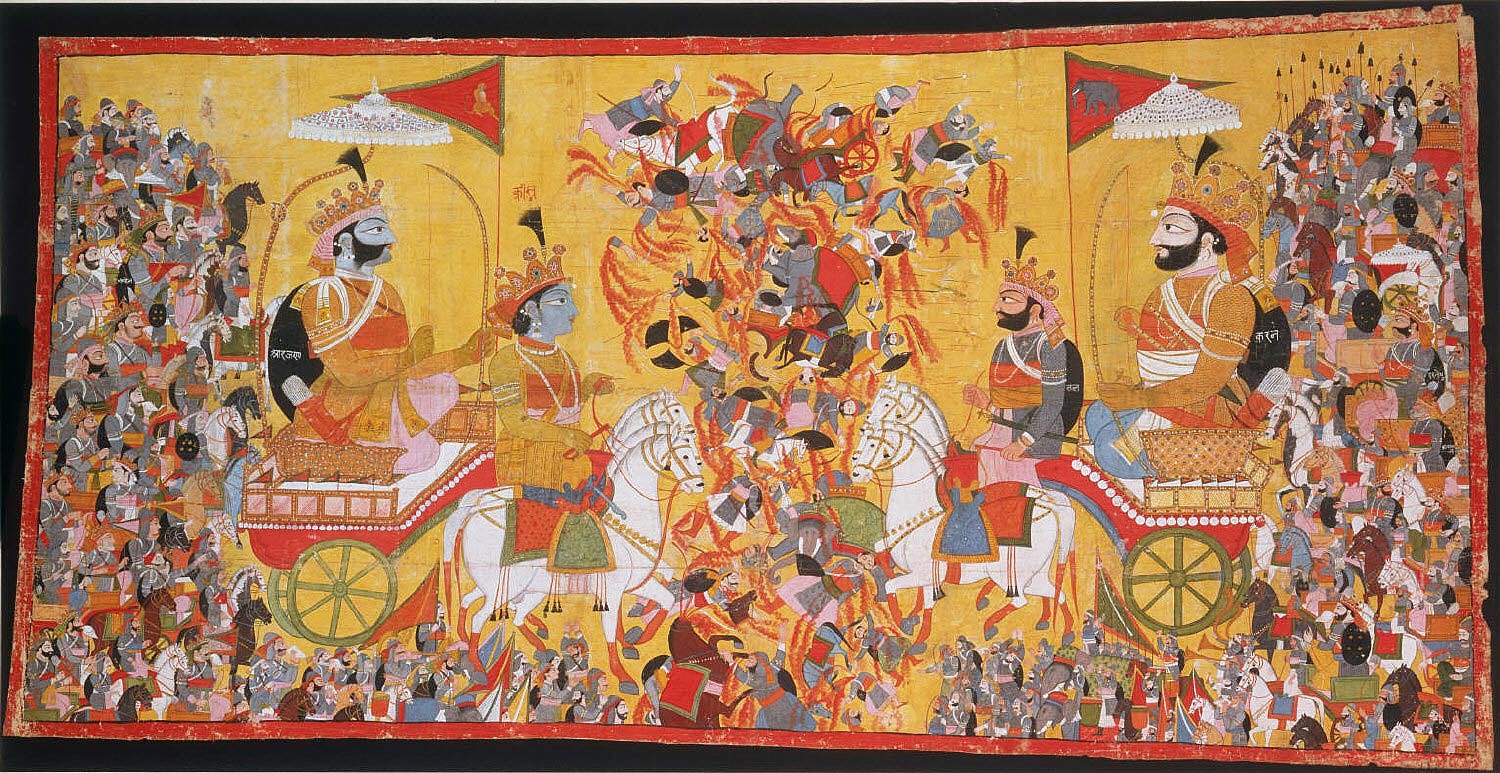 If you have followed
the announcement of Nobel prize for Sciences, there is a curious phenomenon
that you may have observed. Many a times, there are joint winners of the prize
from opposite ends of the planet, who happened
to work on the same scientific problem. They have either arrived independently
at the same solution around the same time or come up with different solutions
that were equally effective. We can only wonder how this happens! In much the
same way, during the 6th and 5th century of BCE, many enlightened spiritual
masters attempted to solve the riddle of human suffering in everyday life. For
example, we have Socrates in Greece, Buddha
and Vyāsa in India and Lao Tsu in China, all of whom took on this same
problem and arrived at answers that were not very different.
If you have followed
the announcement of Nobel prize for Sciences, there is a curious phenomenon
that you may have observed. Many a times, there are joint winners of the prize
from opposite ends of the planet, who happened
to work on the same scientific problem. They have either arrived independently
at the same solution around the same time or come up with different solutions
that were equally effective. We can only wonder how this happens! In much the
same way, during the 6th and 5th century of BCE, many enlightened spiritual
masters attempted to solve the riddle of human suffering in everyday life. For
example, we have Socrates in Greece, Buddha
and Vyāsa in India and Lao Tsu in China, all of whom took on this same
problem and arrived at answers that were not very different.
As you may recall,
the Hindu civilization had by the 6th century BCE, settled down into many small
kingdoms in the Gangetic plains and assimilated the indigenous population into
its fold. A process of consolidation of these kingdoms through wars were also
going on. The society was getting structured with groups of people assuming
different roles like farming, metal working, trading etc. From a religion point
of view, the ritual traditions of the Hindu religion and some purāna stories
were commonly known but the philosophic
side of the religion remained mostly obscure. If one had an interest in
the philosophical aspects, he or she would have to embark on an extensive
search to find a suitable teacher or Guru. The reality of the situation was
that the Hindu religion was doing very little at that time to help the average
person deal with the everyday issues of life. To this scene had arrived Gautama
Buddha with his incredible compassion for the sufferings of the common people.
Buddha's sole quest was how to avoid the suffering like old age,
sickness and death that everyone, both rich or poor, had to undergo. He
accepted the prevailing Hindu concept of rebirth and according to him, the soul
experienced life in an eternal, recurring cycle returning to life from death
through rebirth. Caught into the endless cycle of birth, death and rebirth, the
soul experiences the same suffering over and over. How does one escape from
this? Buddha had found a way and was ready to travel around and spread
information on this to everyone on how it could be done. No one had to go
searching for Buddha. Instead, he went to them, or at least close enough where
they could find him easily.
To enable souls to
gain a release from the eternal birth/death cycle, Buddha suggested a method
that included four fundamental principles (a.k.a., 'noble truths') and an eight
fold path. He called this as the 'middle path'. The 'middle path' was a deviation
away from both the purely ritualistic, God-appeasing path as well as the
atheistic, 'you only live once' kind of mindless enjoyment. This approach,
originally called as 'Baudhayana' or the
'path of Buddha' later on became the religion of Buddhism and was set apart
from Hindu religion. Though the religion
appealed easily to the common people, it
also posed couple of issues. Turning to Buddhism in the way Buddha preached,
required a person to become a monk, giving up his societal connections. This
was very disruptive to the society's functioning. Secondly, Buddha's insistence
on Ahimsa weakened the defensive power of societies, increasing their
vulnerability to external aggression. The real need of the time was for a
religion that supported one to take on a spiritual path that enabled better
life while remaining right in the middle of the society. The Hindu religion
came up with a great answer for meeting this need through Bhagawad Gita. (The
religion of Buddhism also has evolved since to better address these issues)
 Bhagawad Gita, that
is found in the middle of the Mahābhāratha epic, was most likely a 5th or 4th
century BCE insertion into the original epic that dates back to earlier
centuries of BCE. It is thought that Mahābhāratha was originally composed in 24,000 verses and
was later expanded to its current form of 100,000 plus verses. The Vyāsa who
was the author of original Mahābhāratha is potentially different from the Vyāsa
wo authored Bhagawad Gita. Bhagawad Gita itself appears to have been
constructed in three distinct parts that were possibly compiled over different
periods of time. The core message of the Bhagawad Gita, as presented in the
first part consisting of chapters one thru six,
is that spiritual transformation
is a personal journey that could be undertaken while living right in the middle
of the society. A spiritually
enlightened person as well as a non-enlightened person, both may engage in
performing the same actions in life but with extremely different levels of
internal clarity. And, as Buddha had done, Bhagawad Gita also professed a
liberation from the eternal cycle of birth and death for such a person. In
contrast to Buddha's middle path, Bhagawad Gita offered a path of synthesis
that skillfully combined Spiritual knowledge, Devotion, Meditation, Yoga. It
offered an interpretation of the Hindu religion that could be practiced equally
well by a hermit in an Himalayan cave as well as a warrior in the middle of a
battlefield.
Bhagawad Gita, that
is found in the middle of the Mahābhāratha epic, was most likely a 5th or 4th
century BCE insertion into the original epic that dates back to earlier
centuries of BCE. It is thought that Mahābhāratha was originally composed in 24,000 verses and
was later expanded to its current form of 100,000 plus verses. The Vyāsa who
was the author of original Mahābhāratha is potentially different from the Vyāsa
wo authored Bhagawad Gita. Bhagawad Gita itself appears to have been
constructed in three distinct parts that were possibly compiled over different
periods of time. The core message of the Bhagawad Gita, as presented in the
first part consisting of chapters one thru six,
is that spiritual transformation
is a personal journey that could be undertaken while living right in the middle
of the society. A spiritually
enlightened person as well as a non-enlightened person, both may engage in
performing the same actions in life but with extremely different levels of
internal clarity. And, as Buddha had done, Bhagawad Gita also professed a
liberation from the eternal cycle of birth and death for such a person. In
contrast to Buddha's middle path, Bhagawad Gita offered a path of synthesis
that skillfully combined Spiritual knowledge, Devotion, Meditation, Yoga. It
offered an interpretation of the Hindu religion that could be practiced equally
well by a hermit in an Himalayan cave as well as a warrior in the middle of a
battlefield.
A real life example
of this transformative spiritual journey is found in the story of Sage Valmiki.
He had an amazing life journey from being a wayside robber in the forests to
becoming a renowned spiritual master. Sage Valmiki was also a highly imaginative,
creative poet. He managed to metaphorically etch his own spiritual journey
within the epic of Ramayana while painting the picture of a perfect human being
in Lord Rama. (For more detailed reading on Ramayana and Valmiki, check this
blog post http://oupanishadam.blogspot.com/2015/03/ramayana-autobiography-of-rishi.html
)
It will be
delusional to play down the role of faith and belief in religion. As the human society expanded, the chaos and uncertainties only continued to
increase. And, in times of uncertainty, what has served the individuals and
society well is faith in order brought about by a higher, omniscient and
all-powerful being, referred to as 'God'. As the influence of Buddhism declined
and popularity of the Purāna stories increased, the Hindu religion strengthened
itself with a new found means of temple worship of Purānic Gods. The spiritual
masters went along with this trend, again skillfully embedding spiritual
principles within the iconography of the God images and temple rituals. More on
this major transformation that defined the final shape of Hindu religion as we know it today, in the
next blog post.
Meanwhile, grab a
copy of the Bhagawad Gita if you haven't yet. It is a book that can help you
tremendously! (You can find a quick summary of what Bhagawad Gita offers on
this blog post: http://oupanishadam.blogspot.com/2014/02/bhagawad-gita-what-is-in-it-for-you.html)










